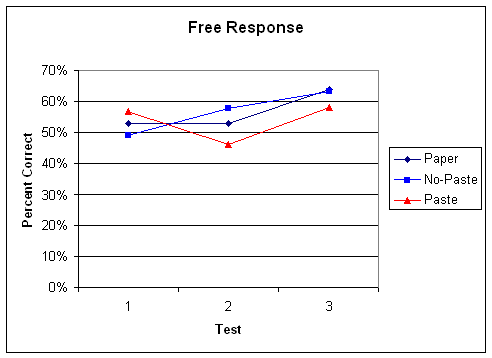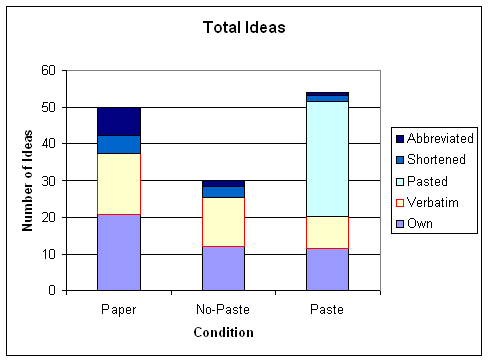Note-Taking: Copy Paste
Contents
Abstract
In a previous study, we found that including copy-paste functionality in a note-taking application appears to be used to increase the quantity of notes students take. In this study (reported in Bauer & Koedinger, 2006) we conducted further evaluations of copy-paste functionality by conducting additional testing and comparing a text-editor that allowed copy-paste with two control conditions, a text-editor that did not allow copy-paste and pencil-and-paper. We found that compared with both control conditions, students given the ability to copy-paste created notes of a far more wordy and verbatim form. Students who could only type took fewer notes than students in the other conditions. While there was no performance difference on individual tests, students using the copy-paste tool appeared to show reduced long-term retention, forgetting more between the immediate and delayed test.
For information on the note-taking project see the top-level page.
Glossary
Select/ion: This term is used in the context of this study to identify the behavior of using the mouse and cursor to actively highlight a portion of digital text. Selection is first step for several online note-taking techniques, including copy-paste and annotation.
Copy-Paste: This is the act of selecting material, copying it to the computer clipboard (via a keyboard shortcut or menu), and then pasting it into students’ notes.
Research Question
Can we improve learning outcomes in online courses by changing the way students can take notes?
Background/Significance
In a previous study (Bauer & Koedinger, 2005), we found that the inclusion of copy-paste functionality in a note-taking application appears to alter behavior when compared with taking handwritten notes. Students took advantage of copy-paste functionality to increase the number of words they recorded. They did not perform differently on an immediate multiple-choice post-test, however.
The study reported hear was aimed at understanding the effect of copy-paste functionality in greater detail. It included both multiple-choice and free-response problem solving questions, as well as robust learning measures of long-term retention. Students were tested immediately, at a one week delay, and at a one week delay after being allowed to review their notes.
Students were placed in one of three conditions, corresponding to the note-taking tool they were given. Some students took notes using pencil-and-paper. Others took notes using a text-editor that did not allow copy-paste. The final group took notes using a text-editor that allowed both typing and copy-paste.
Dependent Variables
Tests
Note: all tests include both multiple choice and free response questions. The multiple choice questions all involve solving problems (for example, given a response structure, which variables are direct causes of an effect, or which interact to produce an effect). In addition, some free response questions ask students to explain terminology used in the module.
Normal Learning, immediate: Students are given a test immediately after studying the material.
Long-Term Retention, Normal Learning: Students return a week following the treatment (which lasts between 30 and 90 minutes) to take this test.
Normal Learning, review: After taking the long-term retention test, students are given their notes to review for 5 minutes. Following this review period, students take a final test.
Behavior
Note-Quantity: The total number of ideas students place in their notes is captured, as well as the number of words used to express those ideas.
Note-Wording: How students word their notes is recorded. Each ideas is either recorded Verbatim, Abbreviated, or in students Own words.
Completion Time: The time students take to complete the learning material is recorded.
Motivation/Interest
Experience: After taking the final test, students are given a survey which solicits their reaction to the tool they used. They are asked to identify their most and least favorite features of the tools, and how they believe the tool affected their note-taking behavior.
Independent Variables
Note-taking Treatment
Paste: Students can create notes by copy-pasting any amount of material from the learning content to their notepad or by typing in the notepad.
Typing: Students can only create notes by typing directly into their notepad.
Pencil-and-Paper: Students take notes using either an pencil or pen on either lined or unlined paper.
Context/Mediating Variables on Student Characteristics
SAT Score: All students are asked to provide their SAT scores, as in previous studies SAT-Math was found to be an important covariate.
Preferences: In the survey, students are asked how they prefer to take notes in their regular student-life.
Hypotheses
- Students using the copy-paste tool to take notes will take more notes than students typing or using pencil-and-paper. This will be
- Students using copy-paste to take notes will learn less than students typing or using pencil-and-paper, as their notes will be less personal.
Findings
- Learning: No statistically significant difference was found on individual tests. A significant time by condition interaction was found between the immediate and delayed (1 and 2) tests for free response questions. Students using copy-paste functionality forgot more than students using the typing tool or pencil-and-paper.
- Ideas: Students using the typing tool recorded fewer notes than the other tools, which were not significantly different.
- Wording:Students using the copy-paste tool recorded significantly more ideas verbatim than the other tools, and pencil-and-paper recorded significantly more ideas in own words.
Explanation
- The results of this experiment do not support our hyptheses, as the novel tools performed worse on learning outcomes than did the standard tools. However, this may be due to usability issues. The Selection tool was the most disliked tool, and users reported disliking the restrictions in the restrited-paste tool. In addition, note-taking behavior was suboptimal, as the novel conditions recorded fewer key ideas than did the standard tools. It may be that the design of the novel tools required more attention to the process of note-taking, rather than the product.
- Lesson: More attention must be paid to the design of note-taking interventions, in order to ensure adoption by users.
- When students are only allowed to copy-paste, they appear to learn as much as when they type. Contrary to previous results, they do not forget more over time. In contrast to the previous experiment, students in the copy-paste condition could not type. This may have increased their attention to the process of pasting. In addition, students in the copy-paste condition showed reduced time on task compared to typing.
- Lesson: Copy-Paste may be a more efficient note-taking technique than typing.
Descendents
Further Information
Bauer, A., and Koedinger, K. “Developing a Note Taking Tool from the Ground Up”. Ed-Media 2005. AACE Press, 4181-4186. Bauer, A., Koedinger, K.R. Pasting and Encoding: Note-taking in Online Courses. In Proc. IEEE ICALT 2006. 789-793

